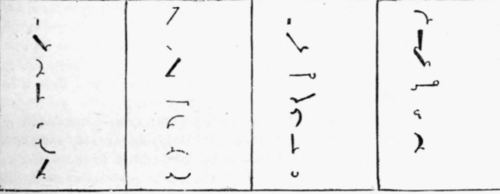Proper Names And Initials
Description
This section is from the book "Haven's Complete Manual Of Practical Phonography", by Curtis Haven.
Proper Names And Initials
The writing in shorthand of proper names and initials being a necessary element to speed in shorthand, since no person can write a proper name in long-hand quickly enough to do verbatim reporting, particular directions are necessary respecting this important subject before concluding the instructions in these lessons. We, therefore, devote several lines of our Exercise to this, beginning with sign 91. The list of initials pretty thoroughly treats of that branch, and the writing of proper names was somewhat explained in an earlier lesson, but there is one point in particular that was not dealt upon - viz: the writing of vowels disjoined in those few instances where it may be advisable, such as in the name of Pike, sign 91; Peck, sign 92; Boyd, sign 94, and in other instances shown herein. The rules which have been given for making vowel junctures are sufficient for most purposes, excepting where the phonetic outline has been written without the visible vowel, in instances where the writer thought it unnecessary at the time, but wherein the writing of subsequent word outlines caused the reporter to fear they might clash with others before written, and he, therefore, has thought it advisable to turn back and insert the vowel. Where this is desired, the vowel can be inserted, as in the instances above illustrated, so long as it is placed between the consonants to which it is to be read, or at least directly after the consonant which immediately precedes it, as in signs 91, 92 and 94, so that it will be read immediately following the proper consonant. In those instances it is comparatively easy to do this, as it also is in the word Price in sign 97, but where the proper name written has been partially formed by a hook, and the vowel is to be read between the main consonant and the hook, then the vowel should be struck through the main consonant, which will indicate that it must be read immediately after the main consonant, and before the hook, just as the vowel E, struck through the letter P in outline for the word Pierce, in sign 96, is read after the P and before the hook R.
This will show the distinction between the word Price in sign 96, and the word Pierce in sign 97, aside from the difference in the vowel sound.
The vowel Ow may be written upward, when it is desired to write Hay downwards, but when Ow is written downwards, it is necessary to write Hay upward. This is illustrated in signs 106 and 107. Many other peculiarities are also illustrated in this Exercise respecting the writing of proper names.
A distinction should be made in some titles. For instance, Miss is of course written with the letter M and circle S above the line, as in sign 98, and Mrs. should be written as in sign 100, that is, with a Sez circle attached to the letter M, as this is the exact sound of that word, but for the word Misses, the plural of Miss, as it occurs very seldom, there should be a distinct form, and it is therefore written with two small circles-S attached to the letter M, as in sign 99. This will clearly distinguish Mrs. from Misses, which are both pronounced the same, and to which the context generally furnishes no key.
The word Katie is written several ways in this Exercise, sign 99 showing it with a vowel ah substituted for a to make a juncture.
Some easily read words, names and titles are not vocalized either with visible vowel or position. See sign 93, etc., of Exercise.
All the substitutions of visible vowels for each other, as shown in this Exercise, are in accordance with the explanations regarding same, given in Lesson IV (Additional Use Of The Visible Vowels), to which the student is referred.
The principle of spelling the sounds of a letter by the union of visible characters, as described in Lesson III (Final List Of Visible Letters) in regard to X and Q, extends also to the representation of all consonants when it is desired to represent the initials of people's names, but not to the vowels. The Roman vowels A, E, I, O or U, when such vowels are used as the initials of personal names, are represented by our phonographic visible vowels, as in signs 98 and 104 in Exercise. But the names of the Roman consonants, when pronounced, always possess a broader sound, and therefore, when representing initials, should be actually spelled with visible signs, as: b-e, B; c-e, C; etc., etc., as in Exercise.
This spelling of the sound of letters when they arc initials representing personal names, gives them a distinctive appearance and enables a reporter always to recognize an initial at a glance. Otherwise, a plain initial might be mistaken in hurriedly written phonography for a word. The following is the complete list:
Initials

Continue to:


